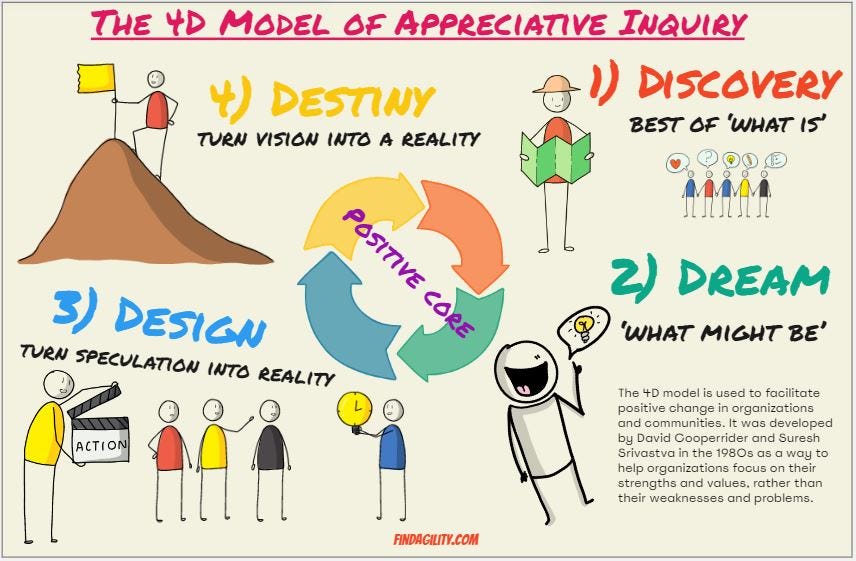The 4D model of Appreciative Inquiry
The 4D model of Appreciative Inquiry is a framework used to facilitate positive change in organizations and communities. It was developed by David Cooperrider and Suresh Srivastva in the 1980s as a way to help organizations focus on their strengths and values, rather than their weaknesses and problems. In this blog post, we will explore the four stages of the 4D model and how they can be applied in a real-life scenario.
The 4D Model of Appreciative Inquiry consists of four stages:
Discovery
Dream
Design
Destiny
Let's take a closer look at each stage:
Discovery: involves identifying an organization's positive core and exploring the stories that surround it. The goal is to identify the organization's strengths, values, and unique qualities that have helped it succeed in the past. This stage involves gathering information from a wide range of stakeholders, including employees, customers, and partners, to gain a comprehensive understanding of the organization's positive qualities. The Discovery stage is critical because it provides the foundation for the rest of the process.
Dream: is about envisioning a positive future for the organization or community. During this stage, individuals are encouraged to imagine what the future could look like if they build upon their strengths and values. This stage is designed to inspire creativity and motivation by encouraging individuals to think big and imagine a positive future.
Design: is for planning and developing strategies to achieve the positive future envisioned in the Dream stage. During this stage, individuals work together to identify specific actions and initiatives that will move the organization or community towards their positive future. This stage is designed to encourage collaboration and teamwork by involving all members in the planning process.
Destiny: is for implementing the strategies and actions developed in the Design stage. During this stage, individuals work to turn their vision into a reality by taking concrete steps towards their positive future. This stage is designed to build momentum and create a sense of accomplishment by seeing positive changes actually take place.
The 4D Model in Practice
Now that we have a better understanding of the four stages of the 4D model, let's take a look at how it can be applied in real-life situations:
A small non-profit organization wants to increase its impact in the community. They decide to use the 4D model of Appreciative Inquiry to help guide their efforts.
Discovery: The organization begins by reflecting on their past successes and values. They identify that they have a strong team with a shared passion for making a positive difference in the community.
Dream: The organization imagines a future where they have increased their impact and have a stronger presence in the community. They envision themselves as a recognized leader in the non-profit sector.
Design: The organization develops a plan that includes expanding their outreach efforts, collaborating with other non-profits, and developing new partnerships with businesses in the community.
Destiny: The organization implements their plan by hosting community events, working closely with other non-profits, and developing new partnerships. They see an increase in their impact and are recognized as a leader in the non-profit sector.
This example demonstrates how the 4D model of Appreciative Inquiry can be used to guide an organization towards positive change. By focusing on strengths and values, imagining a positive future, developing a plan, and implementing strategies, the organization was able to increase its impact and achieve its goals.




